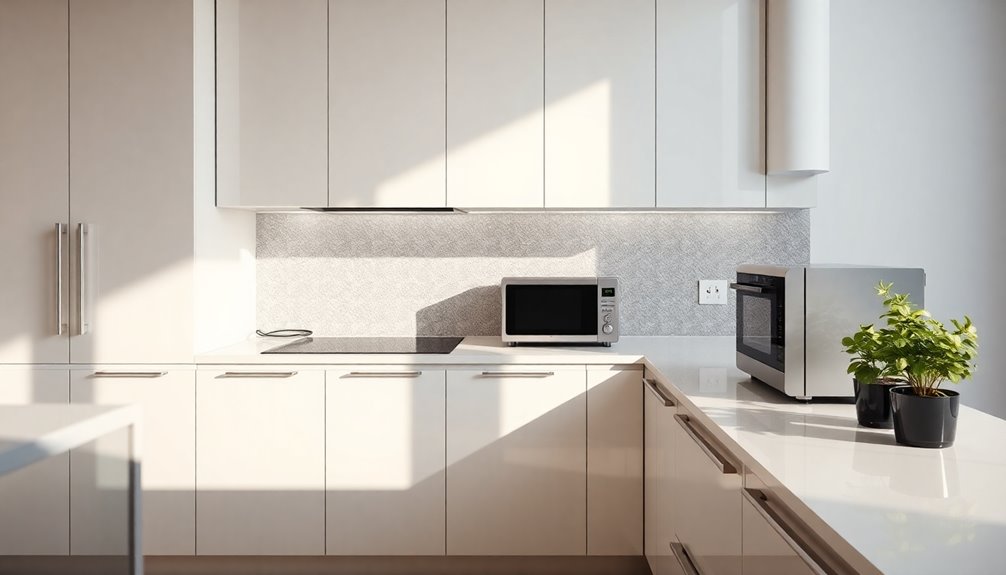To hide outlets in your kitchen, start by checking local electrical codes for compliance. You can camouflage outlets using paintable covers that match your walls or opt for backpainted glass for a stylish touch. Position outlets thoughtfully along backsplashes and consider innovative features like pop-up designs for clean aesthetics. Use decorative items or textiles to conceal unused outlets while ensuring accessibility. If you want more creative ideas and professional tips, keep exploring this topic!
Key Takeaways
- Use paintable outlet covers that match your wall color for seamless blending and to minimize visibility.
- Employ decorative cover solutions or integrated backsplash designs to stylishly conceal outlets while maintaining accessibility.
- Position outlets strategically within tile patterns to keep them discreet yet functional, ensuring compliance with local codes.
- Consider flush-mount outlets or pop-up designs for a clean look when outlets are not in use.
- Utilize larger decorative items or stylish textiles to drape over unused outlets, providing both concealment and decor.
Check Your Local Electrical Code
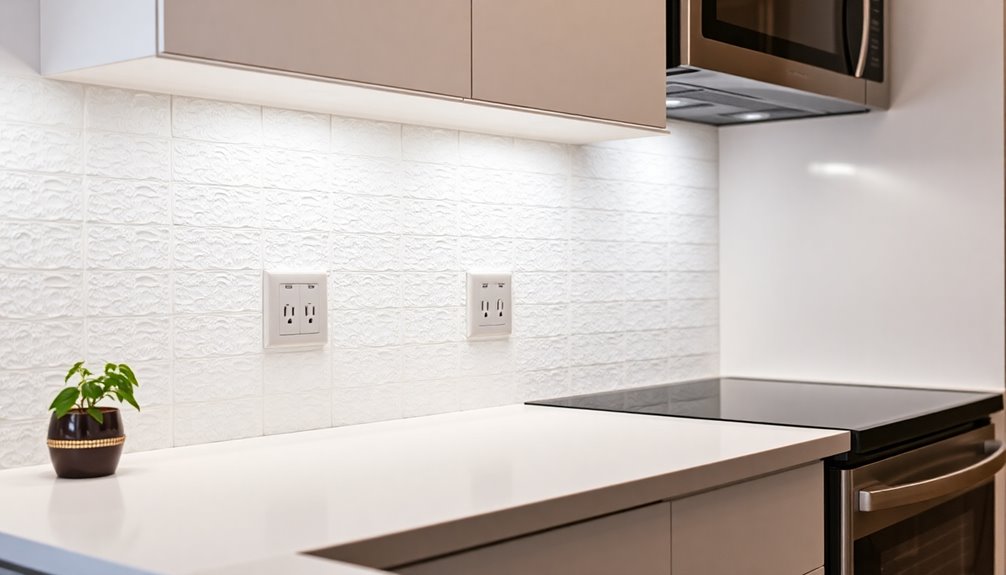
When planning to hide outlets in your kitchen, have you checked your local electrical code?
It's essential to review local building codes before altering outlet placements. Regulations can vary greatly, so don't assume anything.
For instance, in Alberta, Canada, outlets inside cabinets need a limit switch to prevent overheating when doors close. In many U.S. regions, you mightn't need a switch for cabinet outlets, but you must verify this with your local code.
Also, be aware that most electrical codes prohibit face-up outlets in countertops, which can affect your kitchen design.
Consulting a licensed electrician can help guarantee your plans comply with local electrical codes, keeping your kitchen safe and functional.
Camouflage Them
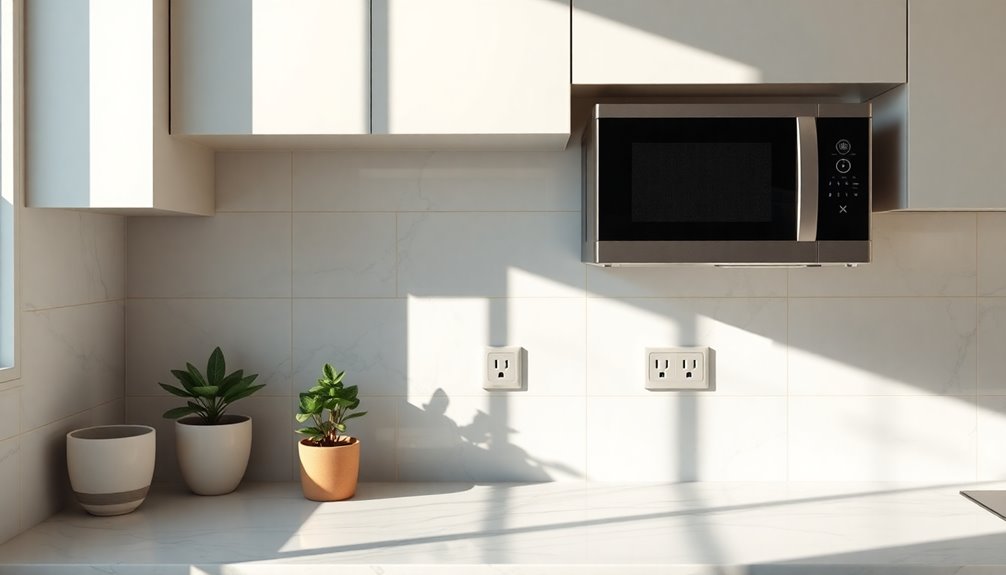
To seamlessly blend your outlets into the kitchen decor, consider camouflaging them with innovative solutions.
Start by using paintable outlet covers that match your wall color, helping you hide electrical outlets effectively. You might also install flush mount outlets from brands like Trufig, which can be customized to blend with surrounding surfaces, creating a minimalist look.
If you prefer a colored option, choose receptacles in shades like Taupe or Dark Bronze for both functionality and style. High-performance paint on outlet covers guarantees durability and washability, maintaining their camouflage in kitchen conditions.
Finally, backpainted glass outlet covers provide a smooth finish, making them easy to clean while enhancing your overall kitchen design.
Outlet Placement
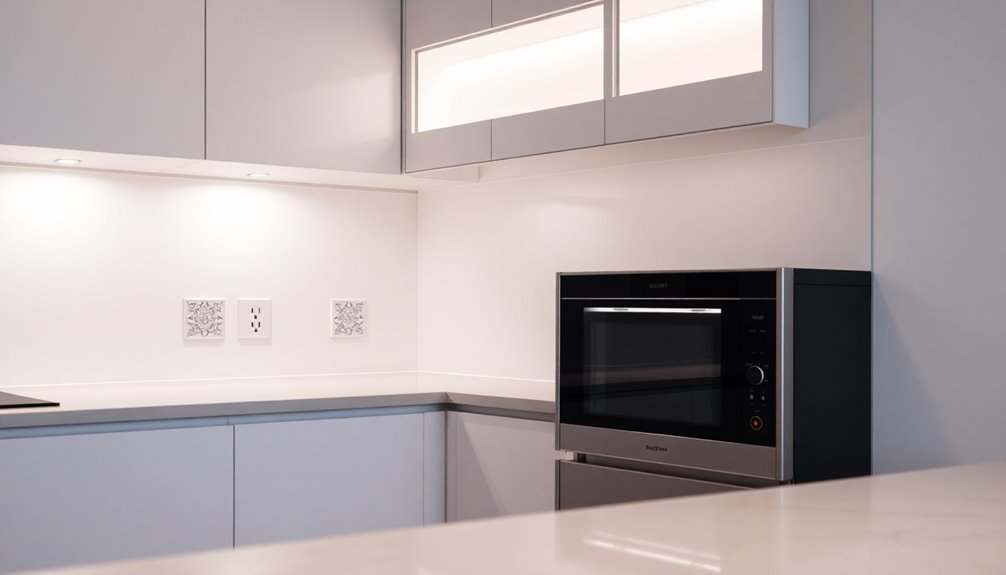
Proper outlet placement is essential for both functionality and safety in your kitchen. Electrical codes require outlets to be accessible within 24 inches of countertop appliances, with a maximum distance of 48 inches between them.
To hide the outlets while adhering to these codes, consider positioning them horizontally along your backsplash tile. This not only meets safety standards but also enhances the kitchen's aesthetics.
Remember, outlets near sinks must be GFCI compliant for added safety. Installing under-cabinet power strips is another discreet option, allowing you to minimize the visual impact of traditional outlets.
Always consult with a licensed electrician to guarantee your outlet placements meet both safety and aesthetic goals during your kitchen design.
Power in Kitchen Islands
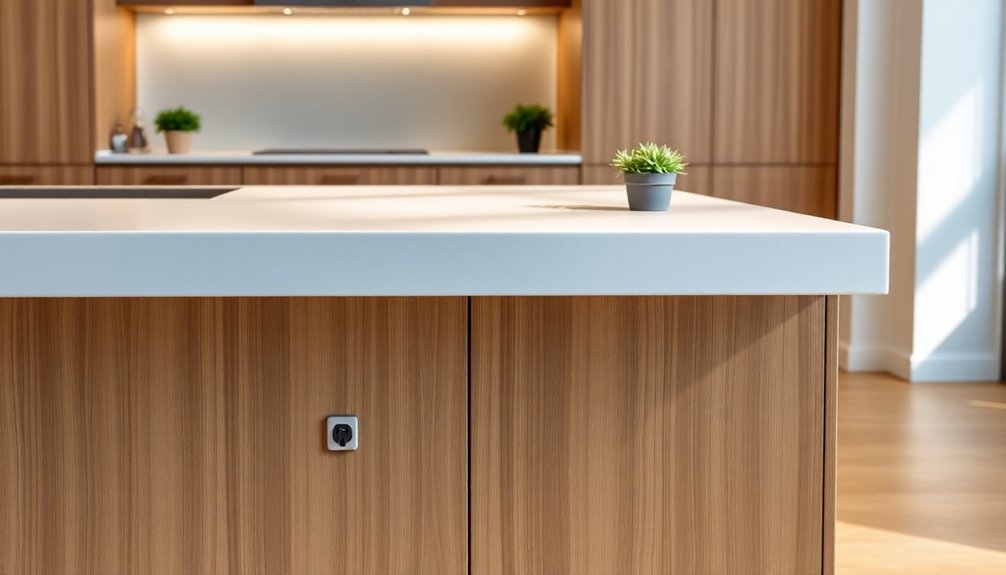
When planning your kitchen island, think about where you'll need power most.
You can choose discreet solutions like pop-up outlets or undercounter power strips to keep your space looking sleek.
Proper outlet placement not only meets code requirements but also enhances the overall aesthetic of your kitchen.
Outlet Placement Guidelines
While planning your kitchen island, it's important to take into account outlet placement to guarantee both functionality and aesthetics.
Kitchen islands typically require at least one outlet on each end to comply with electrical codes, ensuring you have accessible power for countertop appliances.
To keep your design clean, consider installing pop-up outlets in the countertop, allowing them to remain hidden when not in use.
Make sure any outlets placed on the island are at least 20 inches above the countertop for easy access.
Under-counter power strips mounted to the island's underside can also provide discreet access to power while keeping surfaces clear.
Careful planning of outlet placement will create a seamless look that enhances your kitchen's overall design.
Discreet Power Solutions
To create a sleek and functional kitchen island, consider incorporating discreet power solutions that blend seamlessly into your design.
Pop-up outlets are a great choice; they hide away in your countertop when not in use, maintaining a clean look. You might also opt for under-counter power strips, which can be mounted to the underside of the island, keeping outlets accessible while minimizing visibility.
Another smart approach is placing outlets under the countertop overhang, which reduces visual clutter and integrates effortlessly with the island's design.
Remember, to guarantee compliance and safety, it's best to consult a licensed electrician for proper installation and adherence to local building codes.
This way, you'll have a stylish yet practical kitchen space.
Enhancing Aesthetic Appeal
Incorporating power solutions into your kitchen island not only enhances functionality but also elevates the overall aesthetic appeal of the space. By installing pop-up outlets in the countertop, you keep your island sleek and tidy while ensuring convenient access to power.
Consider placing outlets under the countertop overhangs or in toe kicks, allowing you to plug in appliances without cluttering the visual space. Additionally, utilizing under-counter power strips can hide outlets from view, maintaining a streamlined look that complements your cabinets and backsplash.
Thoughtful outlet placement not only meets electrical codes but also creates a harmonious design, blending practicality with style, ensuring your kitchen island remains a focal point of beauty and efficiency.
Cover the Outlets With Accessories
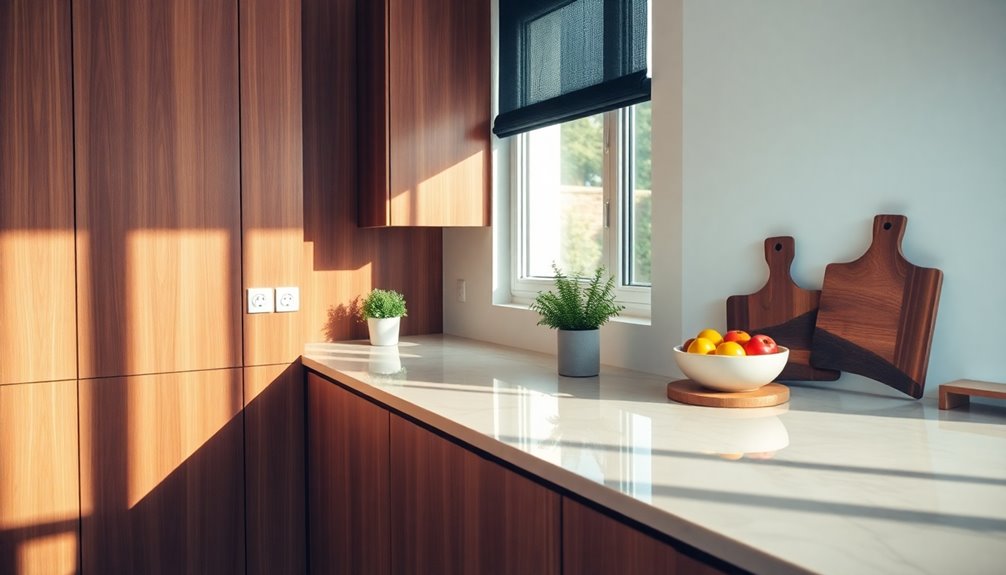
Decorative accessories can be a game-changer when it comes to hiding outlets in your kitchen. You can cover the outlets with decorative items like cutting boards, vases, or art pieces, ensuring they remain accessible.
Opt for larger accessories that effectively conceal outlets while maintaining a clean aesthetic. Incorporate color-coordinated decor that matches your kitchen design for a cohesive look.
Stylish kitchen textiles, such as table runners or placemats, can drape over unused outlets, adding both function and flair.
Don't forget to embrace multifunctional accessories like decorative boxes or storage bins, strategically placed on countertops to serve as both decor and outlet concealment.
With these tips, you'll create a stylish and organized kitchen space.
Embrace the Outlets

Embracing the practicality of visible outlets can transform your kitchen into a more functional space. By choosing to incorporate outlets into your design, you guarantee they're easily accessible for daily use.
Here are three ways to make outlets a seamless part of your kitchen's aesthetic:
- Strategic Placement: Position outlets near under-counter overhangs to blend them with your cabinetry.
- Customized Solutions: Opt for outlets that match your backsplash or cabinet colors, enhancing visual appeal.
- Decor Integration: Use decorative items like cutting boards or plants to incorporate outlets into the overall decor, turning them from eyesores into design elements.
Creative Use of Decorative Items

How can you cleverly disguise those unsightly outlets in your kitchen while enhancing the overall look?
Start by using larger decorative items like planters or wall art to conceal outlets while keeping them accessible. Opt for colorful decor that matches your kitchen's palette, blending outlets into the background.
Strategically place items such as cutting boards, vases, or decorative trays in front of visible outlets to obscure them without sacrificing functionality. Accessories like palm fronds or seasonal decorations add a creative touch while keeping outlets hidden.
Choose decorative items with dual purpose, like storage boxes or baskets, to organize cords and maintain a clean kitchen appearance. This way, you enhance your decor and keep your space looking tidy! Additionally, consider using natural materials that resonate with the farmhouse aesthetic to further integrate your decor with the surrounding elements.
Customizable Outlet Solutions
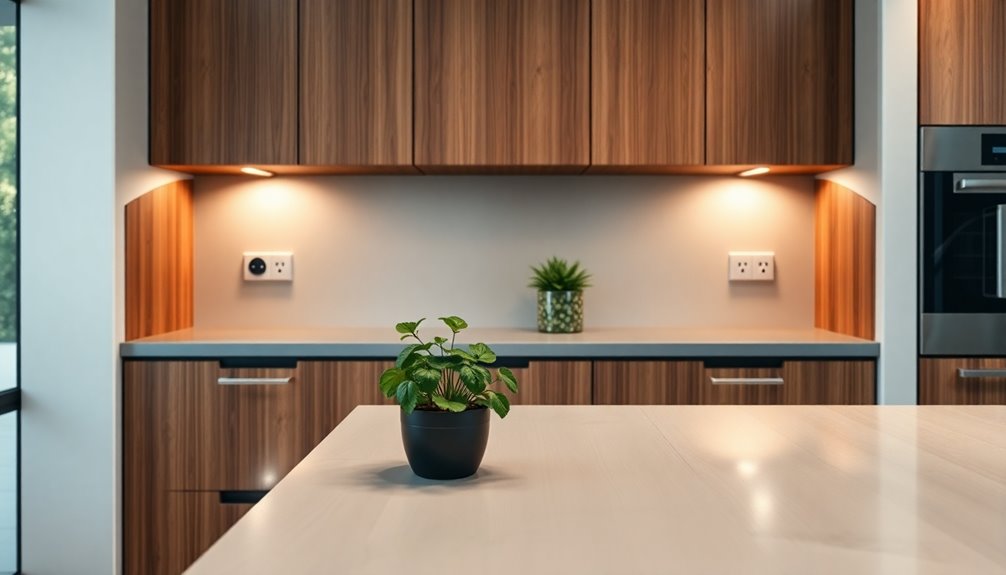
While you may want to keep your kitchen stylish, having accessible outlets is essential. Customizable outlet solutions can help you achieve both functionality and aesthetic appeal.
Here are three benefits of using these systems:
- Tailored Configuration: You can combine outlet boxes with HDMI or USB ports, fitting your specific needs.
- Faux Finish Options: These kits allow for faux painting, enabling you to blend outlets seamlessly with your cabinetry or decor.
- Design Integration: Many solutions integrate directly into kitchen cabinets or countertops, minimizing visual clutter while maintaining accessibility.
Innovative Concealment Techniques
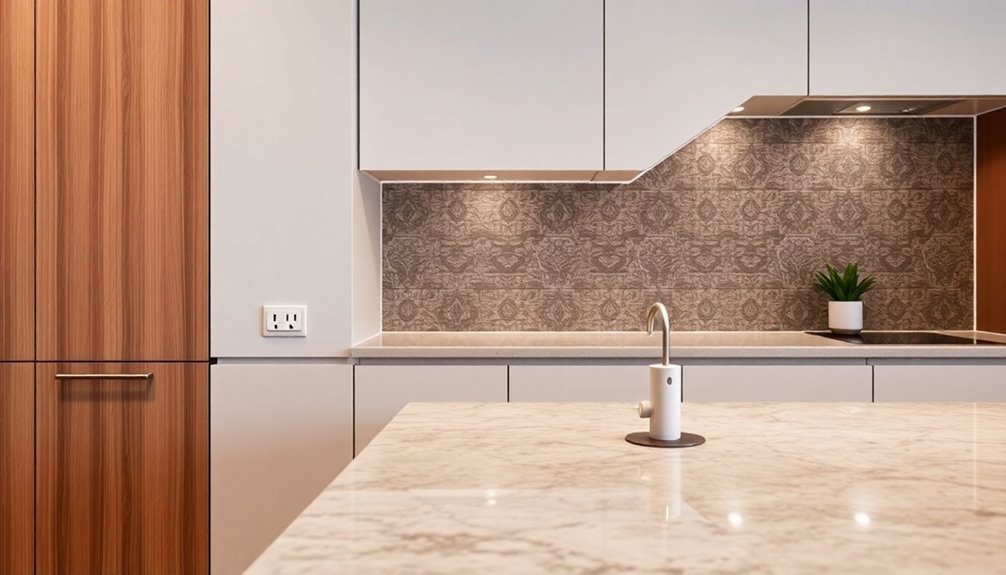
You can achieve a sleek kitchen look with decorative cover solutions that hide outlets while adding style.
Consider integrated backsplash designs that not only conceal power sources but also enhance the overall aesthetic of your space.
Decorative Cover Solutions
To create a cohesive and stylish kitchen, innovative concealment techniques for outlets can make a significant difference. Here are some decorative cover solutions to evaluate:
- Paintable screwless wall plates: These affordable options blend outlets with surrounding surfaces, allowing for a customized look.
- Removable tile cover plates: Products like Simplicover effectively hide outlets behind decorative materials while maintaining accessibility.
- Specialty finish faceplates: Brands like Trufig and DesignMod offer seamless integration with cabinetry and walls, though they may require professional installation.
Additionally, decorative cover plates can be painted or wallpapered for personalization. Customized outlet kits from companies like 22 Systems provide tailored solutions that combine functionality with design.
Incorporating these solutions can also help in maintaining a budget plan that aligns with your overall kitchen renovation goals.
With these options, your outlets can enhance, not detract from, your kitchen's aesthetic.
Integrated Backsplash Designs
Integrating outlets into your kitchen's backsplash design is an ingenious way to maintain a clean and cohesive look. By matching outlet plates with your backsplash colors, you can effectively disguise them while still enjoying modern electrical amenities.
Strategically placing outlets within tile patterns or behind decorative elements keeps them accessible yet visually unobtrusive. Consider using paintable or back-painted glass outlet covers to further enhance the blending with your backsplash materials.
This approach not only optimizes form and function but also guarantees compliance with local codes. Collaborating with a kitchen designer can help you plan the layout of embedded outlets, guaranteeing a seamless integration that elevates your kitchen's aesthetic while meeting all of your electrical needs.
Consulting With Professionals
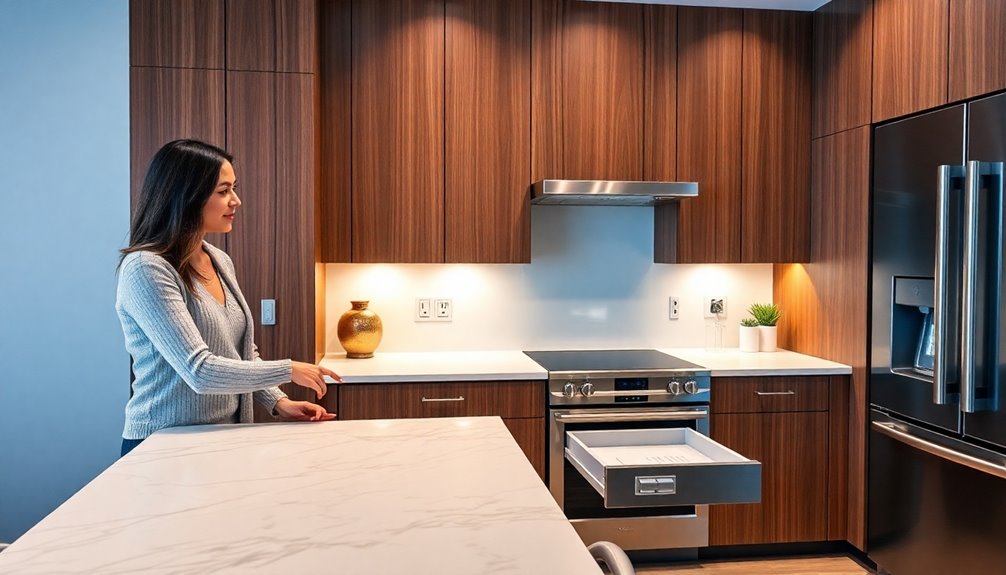
While planning to hide outlets in your kitchen, consulting with professionals is essential for achieving both safety and style.
Working with a licensed electrician and a kitchen designer guarantees your outlet placements meet code requirements while enhancing the overall design.
Here are three key reasons to engage experts:
- Safety Compliance: A licensed electrician guarantees your modifications adhere to local electrical codes, particularly for GFCI outlets near water sources.
- Design Insight: A kitchen designer offers valuable guidance on ideal outlet placements that blend functionality with aesthetics.
- Innovative Solutions: Professionals can suggest creative options like flush-mount outlets or cabinetry integration that you mightn't consider on your own.
Frequently Asked Questions
How Do I Hide Wall Outlets in My Kitchen?
If you want to hide wall outlets, start by considering paintable screwless wall plates that match your wall color.
You can also embed outlets into your backsplash design or use colored receptacles that blend seamlessly with tiles.
Decorative cover plates can add a unique touch, making outlets less noticeable.
Additionally, placing larger items like plants or artwork nearby can help obscure them while keeping access easy.
These strategies create a cleaner, more cohesive look.
How to Make an Outlet Less Noticeable?
Out of sight, out of mind! To make an outlet less noticeable, you can choose paintable screwless wall plates that blend seamlessly with your wall color.
Install flush-mount receptacles for a sleek look, or use removable tile cover plates that match your decor.
Additionally, consider under-cabinet power strips for hidden access, and use decorative items like cutting boards or plants to disguise visible outlets while keeping them accessible.
How Do You Hide Unsightly Wall Plugs?
To hide unsightly wall plugs, you can start by using paintable screwless wall plates that blend seamlessly with your wall color.
Consider decorative cover plates that match your decor for a cohesive look.
Installing under-cabinet power strips keeps plugs out of sight while maintaining a clean countertop.
You might also explore pop-up outlets that remain hidden until needed.
Finally, larger decor items can effectively disguise plugs while keeping them accessible.
Can You Hide an Outlet in a Cabinet?
Imagine you've just remodeled your kitchen, and you want to keep everything looking sleek.
You can hide an outlet in a cabinet, but make certain it's compliant with local electrical codes. For instance, in Alberta, you'll need a limit switch for safety.
Position the outlet so it's easy to access for your appliances. Always consult a licensed electrician to guarantee your setup is safe and meets all necessary regulations.
Conclusion
Incorporating creative solutions to hide kitchen outlets can elevate your space while maintaining functionality. For instance, Sarah transformed her kitchen by installing a pull-out drawer that discreetly houses outlets, keeping them hidden when not in use. This not only enhanced her kitchen's aesthetic but also made it safer for her kids. By considering innovative concealment techniques, you can achieve a sleek, uncluttered look without sacrificing convenience. Embrace these ideas to create a beautiful and efficient kitchen.
